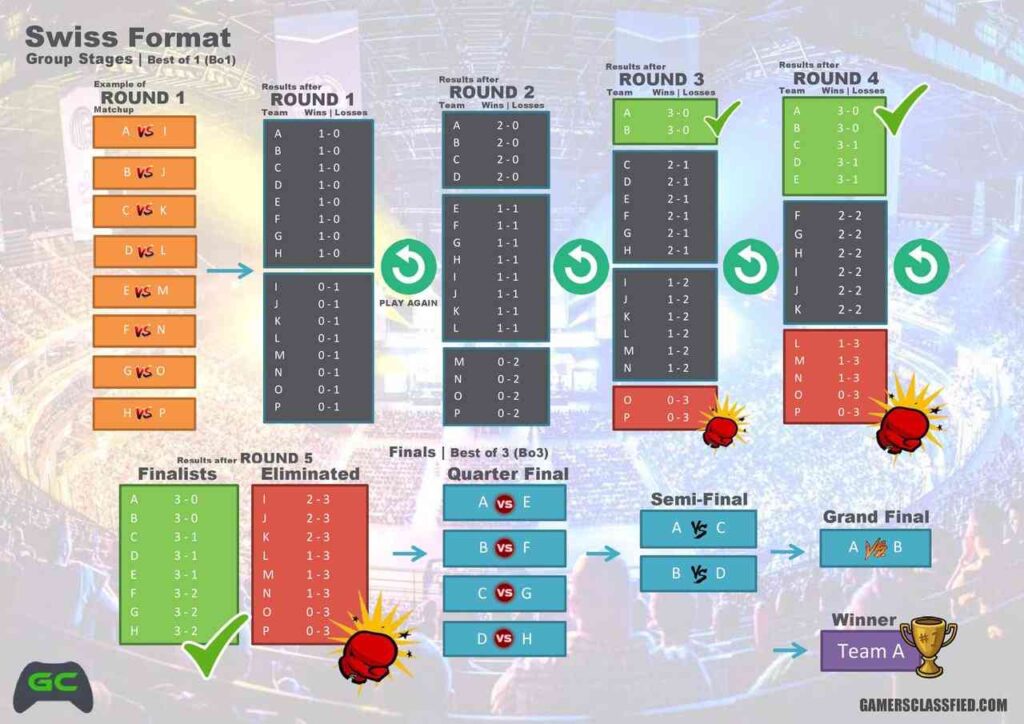Organizers of different esports tournaments often employ the Swiss system format. Whether it’s CS:GO, Dota 2 or Rocket League, there’s a good chance the tournament’s group stage is handled via the Swiss system. But how does it work and what exactly is it that makes it so popular among a wide variety of games?
Contents
Origins and alternatives
The format dates back to the late 19th century. It was developed specifically for chess tournaments as a substitute for previously used formats, such as round robin, where each player plays each other once, or knockout, where the player who loses a match is eliminated from the tournament.
The Swiss system was designed specifically to address the weaknesses of the previously used formats. Round robin, while theoretically offering the most fair environment for competitors, simply takes too long. It’s a solid format if there are only a few teams facing each other, but it’s effectively unusable in most cases.
For example, if your tournament has just 4 participants, they will play 3 rounds and 6 matches in total. However, if your tournament involves 16 teams, there are suddenly 120 matches to be played in the span of 15 rounds.
Knockout eliminator is the polar opposite. A single loss is all it takes to lose the tournament. It offers a fast-paced and dramatic experience, but there’s also a lot of luck in play, so it’s often frowned upon for being too unforgiving and unfair.
How does the Swiss system work then?
There are seven vital rules to keep in mind when talking about the Swiss system.
- The number of rounds is decided beforehand.
- Two players cannot face each other more than once.
- A player doesn’t have to face every rival.
- The initial pairings are decided either completely randomly or based on a rating system, pairing similarly skilled competitors.
- The following pairs are decided based on the results from the previous rounds. Players who won their matches are put against each other and the same applies to those who lost.
- If the number of participants is odd, the player who skips a round receives a bye – gaining a free point. However, each player is limited to a single bye for the whole duration of the tournament.
- The player with the most points at the end of the final round is declared a winner.
By sticking to these rules, the Swiss system mitigates the weaknesses of the older formats. It can handle a huge amount of competitors, while significantly reducing the role of luck, thus creating a fair environment for the participants. For example, with 100 players, the Swiss format can determine the winner within just 9 rounds. Round robin would require a whopping 99 of them!
Are there any disadvantages?
Obviously, nothing’s truly only black or only white. The same applies to the Swiss system. We’ve already mentioned its pros, so what are the cons?
Well, first and foremost, while it mitigates the negative aspects of both knockout and robin, it doesn’t fully eliminate them. That means, there’s still some luck involved, although to a limited degree. From a competitor’s perspective, it could also be argued its next weakness stems from the intent to pair similarly skilled opponents against each other. If you’re a strong competitor, you get matched with the best.
That translates into an increased chance to lose the opening round, so you have to recover from that quickly and not lose your spirit ‘ otherwise, you’ll get chewed up by opponents in the rest of your matches.
The weaker-rated participants can capitalize on this ‘ if they get a good, strong headstart and head into the rest of the rounds with a winning mindset.
Thankfully, from the point of view of an esports fan, this allows for interesting comeback arcs of the tournament’s underdogs.
The last weakness that the Swiss system has, is the lack of the risky and fast-paced thrill that can be experienced in eliminators. Fortunately, there is a way around this’¦
How does a typical esports tournament utilize the Swiss system?
If we look at the structure of most esports tournaments, there’s a clear pattern. Let’s analyze how it goes for a 16-team tournament.
In most cases, it’s not the standard Swiss, as we might often see in chess tournaments. Instead, to make things more attractive for viewers, the tournament is divided into a group stage and an eliminator stage.
The Swiss system comes into the spotlight during the group stage. In a total of 5 rounds, the condition to move on into the eliminator stage is for a team to have 3 victories. This splits the playing field in half. Losers go home, while the winners head into the eliminator with quarter-finals, semi-finals and a final.
 An infographic showcasing the typical structure of an esports tournament. Image source: steemitimages.com
An infographic showcasing the typical structure of an esports tournament. Image source: steemitimages.comThis ensures that the format provides an objectively fair environment for teams to compete in, while simultaneously delivering the thrill and emotion of a nail-biting final showdown.


